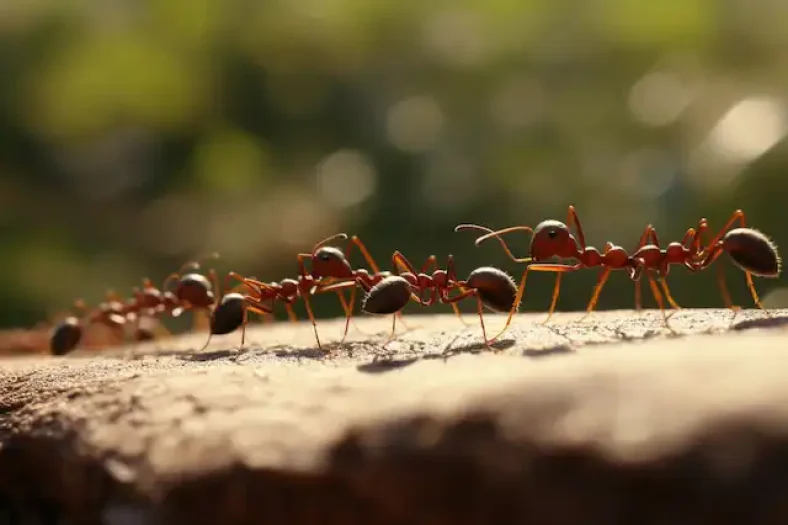We’ve all been there – it’s a fine morning, the sun is shining, you pour some kibble into your beloved Fido’s bowl, and then…you see them. Tiny, relentless thieves, marching one by one, trying to turn your pet’s breakfast into their personal picnic.
Yes, we’re talking about ants. They might be nature’s tiny soldiers, but when they start invading your pet’s food, it’s time for a little strategy session.
In this post, we’ll dive into understanding the ant-agonists, discuss why they just can’t resist your pet’s dinner, and arm you with an arsenal of tips, tricks, and tactics to make your pet’s mealtime an ant-free zone. Let’s get started!
Contents
The Ant-agonist: Understanding Ant Behavior
Ants, as annoying as they are, are fascinating creatures. Their entire life revolves around two main tasks – gathering food and ensuring the survival of their colony.
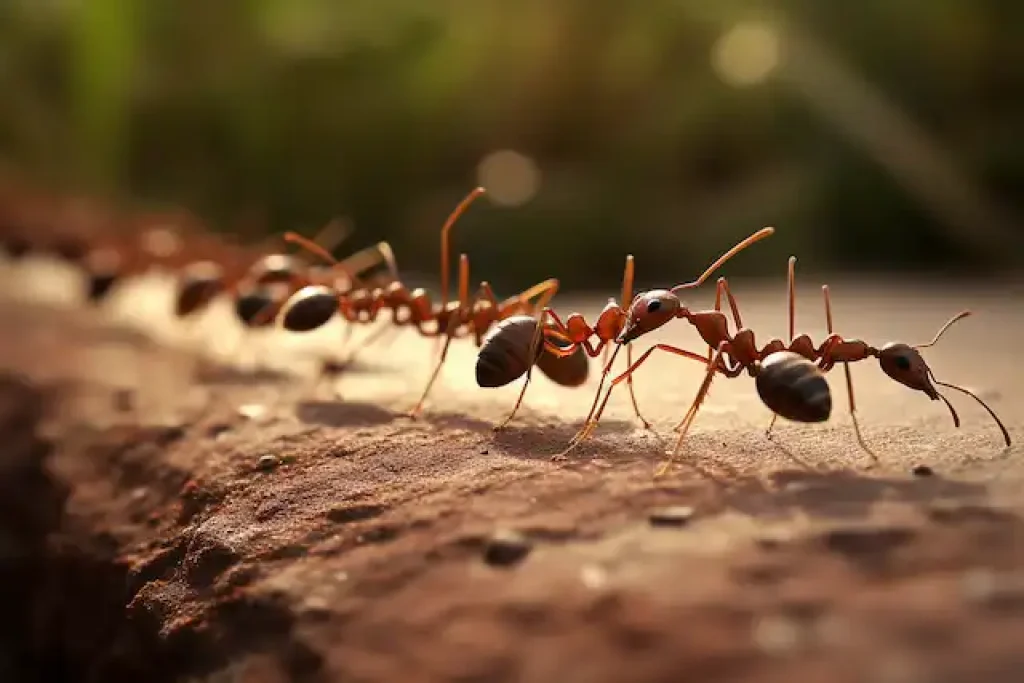
Your pet’s food, packed with proteins, sugars, and fats, is a buffet they just can’t resist. The aroma wafts to their antennae, and boom – it’s party time.
Not only do they have an acute sense of smell, but they’re also brilliant communicators. One ant finds the food, leaves a chemical trail on its way back to the colony, and before you know it, you have a full-blown ant highway heading straight to your pet’s dinner.
But this isn’t just a matter of annoyance or stolen kibble. Ants carry bacteria, and if they contaminate your pet’s food, it can potentially lead to stomach upset or other health issues for your furry friend. This makes it more than just an inconvenience – it’s a matter of pet safety.
Now that we understand why ants are so drawn to our pet’s food let’s get into how we can defend it.
The Chow Attraction: Why Ants Invade Pet Food Areas
Ants are survivors and opportunists. When they spot an easy food source, they will exploit it relentlessly. A pet’s food area can turn into an ant haven for several reasons:
Your Pet’s Food is a Five-Star Restaurant
Ants love the same things your pets do: proteins, fats, and sugars. The smell of pet food, whether it’s kibble or canned, is like a siren song to them, calling them to feast.
A Crumbly Situation
If your furry friend is a messy eater, leaving crumbs or bits of food scattered around their bowl, it’s like leaving a welcome mat for the ants. They love nothing more than finding these tidbits of delight scattered about.
Location, Location, Location
The location of your pet’s food bowl can also impact ant attraction. If the feeding area is near a window, door, or any area where ants can gain easy access, it makes the journey to the food source even shorter for these tiny intruders.
Knowing these common reasons why ants might invade your pet’s feeding area helps us plan effective countermeasures. So, let’s put on our battle gear and dive into the world of ant prevention!
Unleashing the Big Guns: Prevention Measures
Ants may be relentless, but with some clever strategies, you can keep them at bay and protect your pet’s food. Here are some preventative measures to consider:
Mealtime Isn’t All the Time: Proper Food Storage
Let’s face it: it’s hard to resist an open buffet. By storing pet food in airtight containers, you make it less accessible to our tiny invaders. Additionally, refrigerating wet food can also lessen the smells that attract ants. A little effort here will save you a lot of annoyance later.
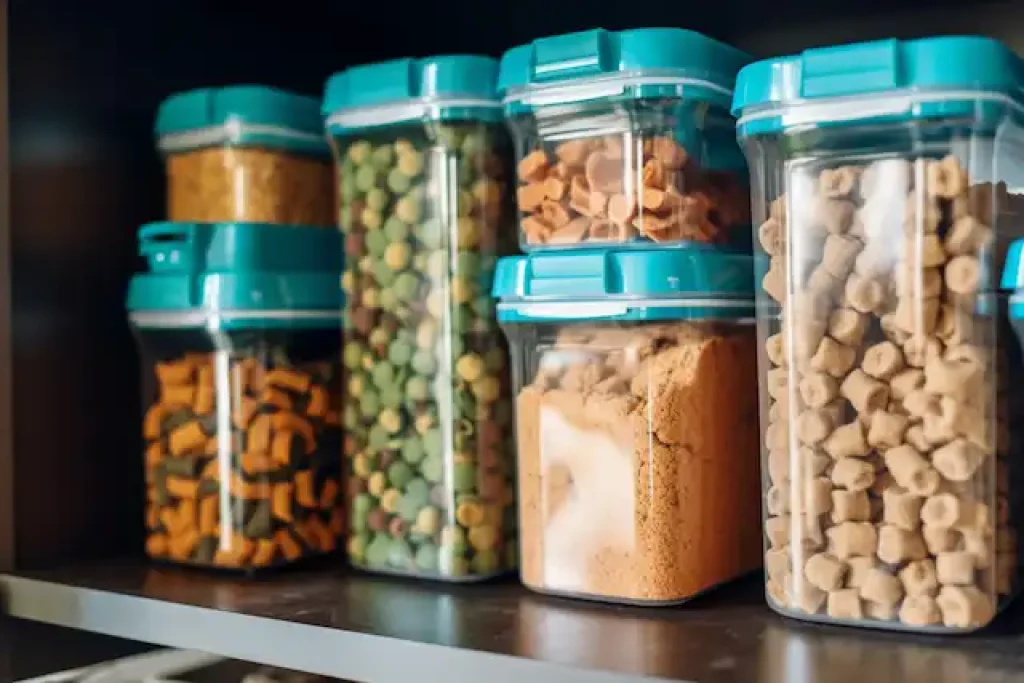
Cleanliness is Next to Antlessness: Keeping the Feeding Area Clean
Your pet might enjoy a laid-back lifestyle, but leaving their feeding area messy isn’t an option if you want to avoid ants. Regularly clean your pet’s food and water bowls and sweep the area around it to remove crumbs or spilt food. Remember, even a tiny morsel can attract a scout ant.
Strategize with Locations: Consider the Feeding Spot
If ants have easy access to your pet’s food, they’re going to take advantage of it. Consider moving the feeding area away from windows, doors, and any known ant entry points. An elevated pet bowl can also help keep ants from reaching the food.
Preventing an ant invasion can often be a simpler solution than dealing with one. But if the ants have already marched in, don’t worry – we’ve got a few tricks up our sleeve to get rid of them too.
Turning to Mother Nature: Natural Repellants and Barriers
Ants might seem unstoppable, but there are certain things they simply can’t stand. By using natural repellants and barriers, you can create a defensive fortress around your pet’s food. Let’s explore some of these natural solutions:
Repel, Don’t Kill: Vinegar and Cinnamon
Vinegar and cinnamon are excellent natural ant deterrents. A solution of equal parts water and vinegar or sprinkling cinnamon around the feeding area can help keep ants away. These substances disrupt the pheromone trails that ants leave, causing them to lose their path.
Barrier Alert: Diatomaceous Earth
This non-toxic powder is made from fossilized aquatic organisms and can be sprinkled around your pet’s feeding area. Ants, not being fans of this substance, tend to avoid it, making it an excellent barrier. Just make sure you use food-grade diatomaceous earth, which is safe for pets.
DIY Ant-Repellant Sprays
Mixing essential oils like peppermint, citrus, or eucalyptus with water can create a spray that ants dislike. Spray it around your pet’s feeding area for an ant-free zone. But remember to use these sparingly and cautiously as some pets may have reactions to strong scents.
Using natural repellants can be an excellent first line of defense in keeping ants away from your pet’s food. If the invasion continues, it might be time to bring in commercial reinforcements.
Call in the Reinforcements: Commercial Ant-Control Solutions
When natural remedies aren’t enough, or if the ant infestation is persistent, commercial ant-control solutions may be necessary. Remember, the safety of your pets should always come first when selecting these products.
Ant Traps: Discreet and Effective
Ant traps attract ants with a food source (usually sweet), which they carry back to their colony, poisoning it in the process. These can be placed discreetly around your home and are generally safe for pets. Just make sure to follow the manufacturer’s instructions carefully.
Pet-Friendly Ant Sprays: A Handy Backup
Ant sprays can also be used, but caution is needed. Opt for a pet-friendly formula and use it away from your pet’s feeding area and other areas they frequent to avoid any accidental ingestion.
Ant-Proof Pet Bowls: A Modern Solution
Innovation has brought us specially designed pet bowls to prevent ants. These usually come with a water-filled moat around the bowl, deterring ants from reaching the food. It’s a simple, mess-free solution that’s worth considering.
Commercial solutions can offer a more hands-off approach to dealing with ants. However, if these still aren’t enough, or if the infestation seems severe, it might be time to consider professional help.
When the Ants March On: Considering Professional Help
Sometimes, despite our best efforts, ants might just keep on coming. In such cases, it might be time to call in the professionals.
Here’s what you need to know:
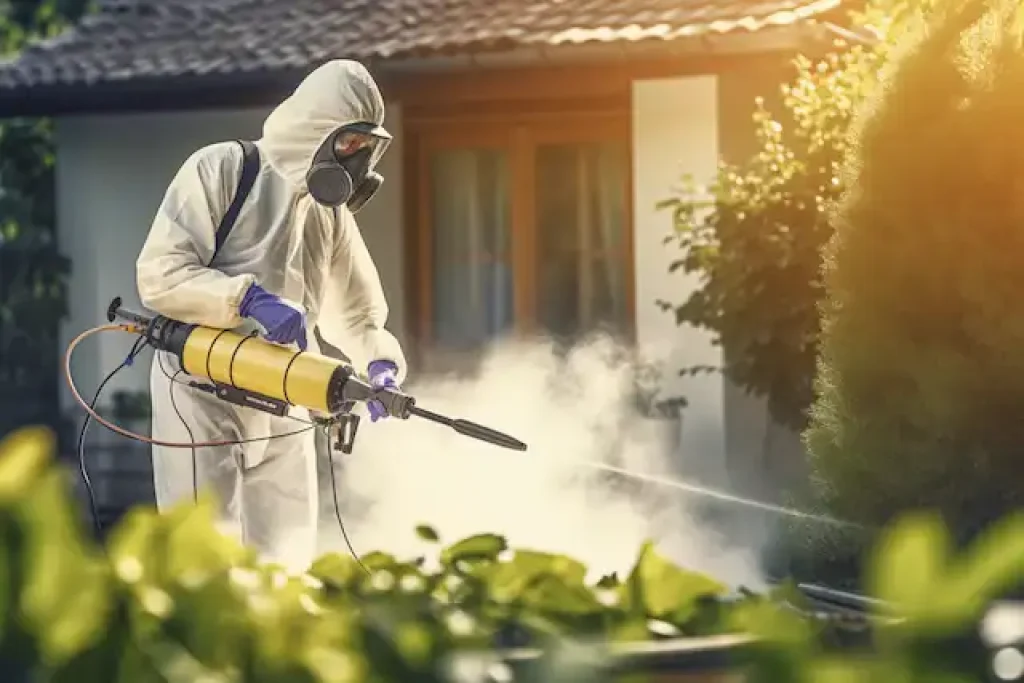
Recognizing the Need: When to Call a Professional Exterminator
If your ant problem persists over several weeks, if you notice large mounds of ants inside or outside your home, or if you suspect you’re dealing with a more harmful species like fire ants or carpenter ants, professional help is recommended.
Choosing the Right Exterminator: A Pet-Friendly Focus
Ensure the exterminator you choose is aware of your pets and is prepared to use pet-friendly methods and substances. Always confirm their process, and make sure you understand any safety measures you may need to take for your pet.
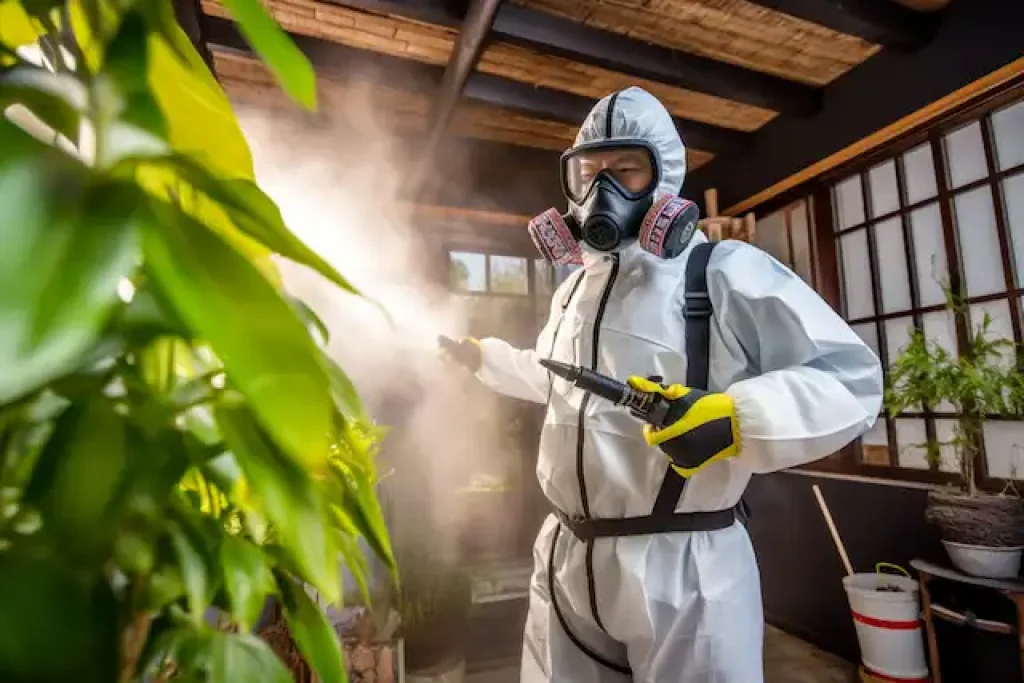
Professional help can be the final step in ridding your home of ants. They bring expert knowledge and tools that can help resolve even stubborn infestations.
Don’t be disheartened if you end up needing professional help. Battling ants can be a tough job, but with some diligence and the right help, your pet’s food can become an ant-free zone.
The Secret Weapons: Additional Tips and Tricks
In our war against ants, every trick counts. Here are some additional strategies that can give you an upper hand:
Double Bowl Strategy: Water Moat
One ingenious trick is to place your pet’s food bowl inside a larger shallow bowl filled with water. The water acts as a moat, keeping the ants from reaching your pet’s food. Just be sure to change the water regularly!
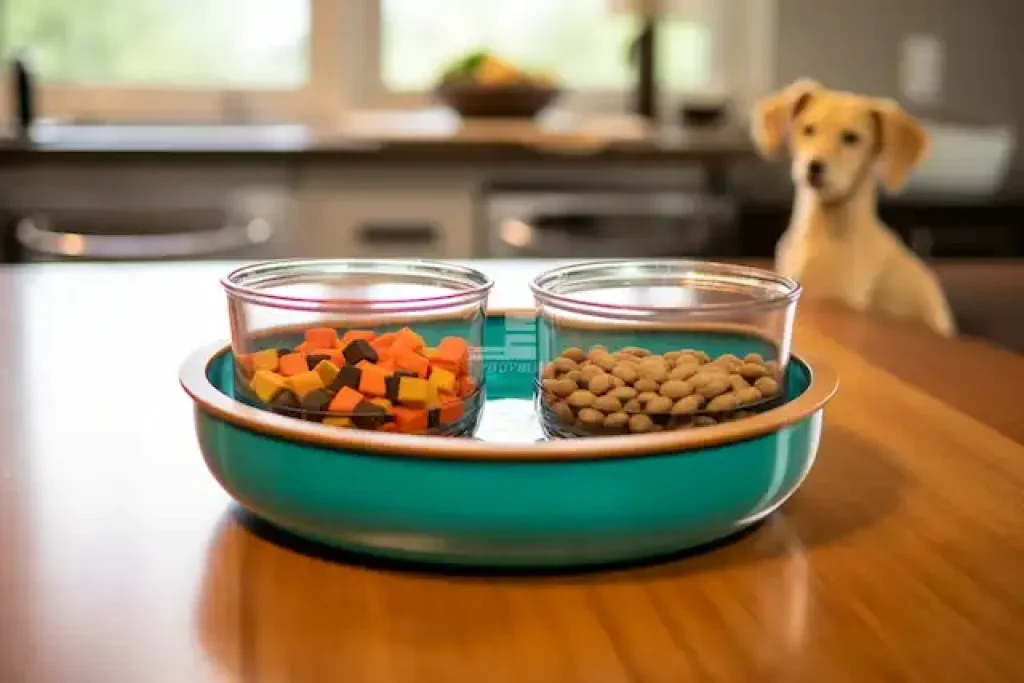
Using Pet-Safe Ant Deterrent Plants
Certain plants, like peppermint and tansy, are known to repel ants. Planting these around your house or near the feeding area can be a natural and pleasing way to keep ants at bay.
Regularly Check and Seal Entry Points
Ants are tiny and can fit through the smallest cracks. Regularly check for possible entry points and seal them. This can include gaps in doors or windows, cracks in walls, or spaces around pipes.
These are just a few more tools for your ant-fighting arsenal. Remember, consistency is key in keeping those tiny invaders at bay.
By now, you’re armed with some serious knowledge and strategies to keep your pet’s food ant-free. Let’s wrap it all up.
FAQs
Why are ants attracted to my pet’s food?
Ants are attracted to the proteins, sugars, and fats in pet food. The scent of the food, whether dry or wet, acts like a beacon for these tiny scavengers.
Can ants in my pet’s food harm them?
Yes, ants can carry bacteria which could potentially lead to stomach upset or other health issues in your pet. Some species of ants can also bite, causing discomfort or even allergic reactions in some pets.
Can I use any kind of vinegar for a natural ant repellant?
Any type of vinegar will work as an ant deterrent. It’s the acidity in the vinegar that disrupts the ant’s trail scent.
Are commercial ant sprays safe for pets?
Not all ant sprays are safe for pets. Always opt for pet-friendly formulas, and use them with caution. Always keep sprays away from your pet’s feeding area and other areas they frequent to avoid any accidental ingestion.
When should I consider calling a professional exterminator?
If the ant problem persists over several weeks, if you notice large mounds of ants, or if you suspect you’re dealing with a more harmful species of ants, it’s time to call in the professionals.
What should I do if my pet accidentally eats food that’s been infested with ants?
If your pet eats food that ants have been in, monitor them for signs of distress such as vomiting, diarrhea, or loss of appetite. If you notice any of these symptoms or if you’re concerned, contact your vet.
Remember, it’s always better to prevent ants from reaching your pet’s food in the first place. The tips in this blog will help you create a safe, ant-free zone for your pet’s meals.
Conclusion: Winning the Battle Against Ants
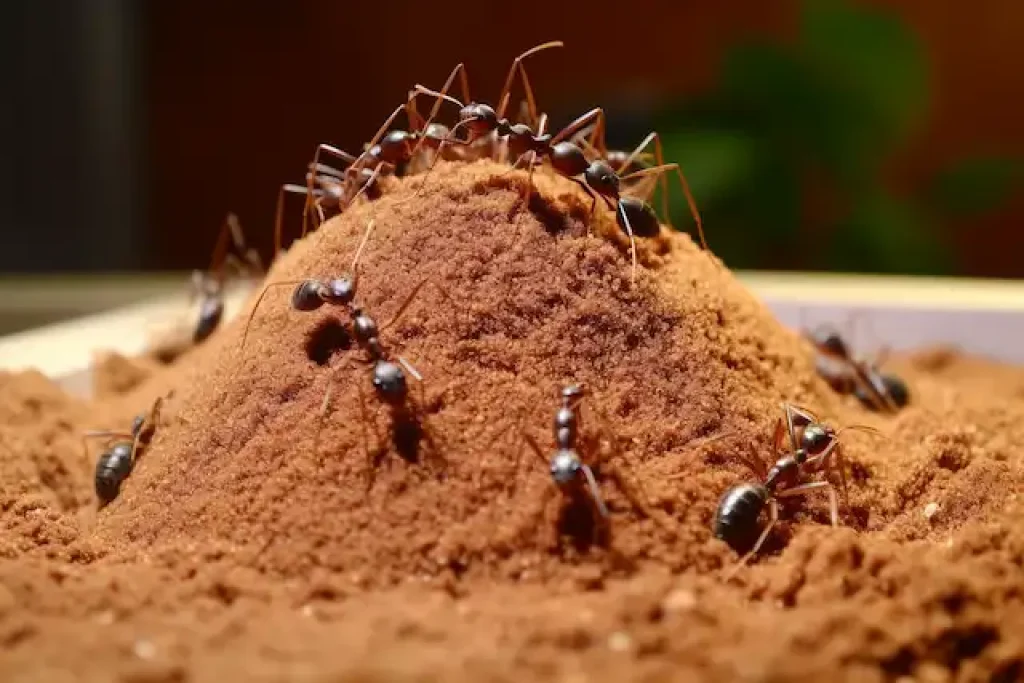
We hope this guide equips you with the knowledge and tools you need to win this battle. Remember, consistency is key, and a little bit of effort can go a long way in keeping your pet’s food safe and ant-free.
So, suit up, strategize, and declare your home an ant-free zone. Your pet (and their dinner) will thank you!

